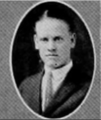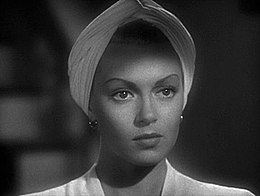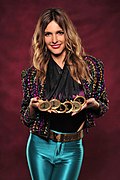Our website is made possible by displaying online advertisements to our visitors.
Please consider supporting us by disabling your ad blocker.
Portal:Television
The Television Portal

Television (TV) is a telecommunication medium for transmitting moving images and sound. Additionally, the term can refer to a physical television set rather than the medium of transmission. Television is a mass medium for advertising, entertainment, news, and sports. The medium is capable of more than "radio broadcasting," which refers to an audio signal sent to radio receivers.
Television became available in crude experimental forms in the 1920s, but only after several years of further development was the new technology marketed to consumers. After World War II, an improved form of black-and-white television broadcasting became popular in the United Kingdom and the United States, and television sets became commonplace in homes, businesses, and institutions. During the 1950s, television was the primary medium for influencing public opinion. In the mid-1960s, color broadcasting was introduced in the U.S. and most other developed countries.
In 2013, 79% of the world's households owned a television set. The replacement of earlier cathode-ray tube (CRT) screen displays with compact, energy-efficient, flat-panel alternative technologies such as LCDs (both fluorescent-backlit and LED), OLED displays, and plasma displays was a hardware revolution that began with computer monitors in the late 1990s. Most television sets sold in the 2000s were still CRT, it was only in early 2010s that flat-screen TVs decisively overtook CRT. Major manufacturers announced the discontinuation of CRT, Digital Light Processing (DLP), plasma, and even fluorescent-backlit LCDs by the mid-2010s. LEDs are being gradually replaced by OLEDs. Also, major manufacturers have started increasingly producing smart TVs in the mid-2010s. Smart TVs with integrated Internet and Web 2.0 functions became the dominant form of television by the late 2010s.[better source needed] (Full article...)
Selected article -
Selected image -

The Kaknäs tower (Swedish: Kaknästornet) is a TV tower in Gärdet in Stockholm, Sweden. It has 72 pillars. The tower is a major hub of Swedish television, radio and satellite broadcasts. It was finished in 1967, designed by architect Bengt Lindroos, and the height is 155 metres (509 ft) or 170 metres (560 ft) with the antenna included. The tower is owned by the national Swedish broadcasting company Teracom. The tower's name comes from the ancient name of the area, Kaknäs.
Did you know (auto-generated) -

- ... that Singaporean singer Dawn Gan played herself in a television drama about aspiring singers?
- ... that Windows 3.1 had a special version, known as Modular Windows, that was controlled via television?
- ... that Alan Rosen once sold 2,400 cheesecakes in four minutes to television shoppers?
- ... that in the television series sequel Imortal (2010), Angel Locsin portrayed the lead role as the daughter of her lycan character in the Lobo TV series?
- ... that a television station spent so little on programming that a media columnist called it the "IOUs of Cincinnati"?
- ... that Milton Grant went from disc jockey and bandstand host to an owner of television stations?
Selected quote -
More did you know
- ...that the book The Psychology of The Simpsons uses this TV series to analyze topics in psychology including clinical psychology, cognition and Pavlovian conditioning?
- ...that popular 1950s game show Down You Go is one of the only U.S. television series to air on all four networks of television's Golden Age: ABC, NBC, CBS and DuMont?
- ...that the participants of the Channel 4 programme Dumped were not told that they would be living on a landfill site for three weeks?
- ..that the time traveling premise featured in the Chrono series of video games was inspired by such television programs as The Time Tunnel?
- ...that Dr. Andrew Rochford, a presenter on the popular Australian television show What's Good For You, got his break after he won the popular show The Block?
Selected biography -
Katherine Dee Strickland (born December 14, 1975) is an American actress. From 2007 to 2013, she played Dr. Charlotte King on the ABC drama Private Practice.
Strickland began acting during high school. She studied acting in Philadelphia and New York City, where she obtained mostly small roles in film, television, and stage projects, among them The Sixth Sense (1999). Her participation in the 2003 Hollywood films Anything Else and Something's Gotta Give led to her receiving significant parts in the 2004 horror films Anacondas: The Hunt for the Blood Orchid and The Grudge. She was then referred to as "the pride of Patterson" and the horror genre's "newest scream queen", though her performances in both films received mixed critical reviews. In 2005, she garnered positive critical reviews for the romantic comedy Fever Pitch, and she was a regular on the television show The Wedding Bells in 2007. She was subsequently added to the cast of Private Practice. (Full article...)
General images
News
- December 28: US professional wrestler Jon Huber dies aged 41
- September 2: Tributes paid to recently deceased US actor Chadwick Boseman
- May 24: Japanese professional wrestler and Netflix star Hana Kimura dies aged 22
- January 16: BBC newsreader Alagiah to undergo treatment for bowel cancer
- Upcoming events
Featured content
Main topics
History of television: Early television stations • Geographical usage of television • Golden Age of Television • List of experimental television stations • List of years in television • Mechanical television • Social aspects of television • Television systems before 1940 • Timeline of the introduction of television in countries • Timeline of the introduction of color television in countries
Inventors and pioneers: John Logie Baird • Alan Blumlein • Walter Bruch • Alan Archibald Campbell-Swinton • Allen B. DuMont • Philo Taylor Farnsworth • Charles Francis Jenkins • Boris Grabovsky • Paul Gottlieb Nipkow • Constantin Perskyi • Boris Rosing • David Sarnoff • Kálmán Tihanyi • Vladimir Zworykin
Technology: Comparison of display technology • Digital television • Liquid crystal display television • Large-screen television technology • Technology of television
Terms: Broadcast television systems • Composite monitor • HDTV • Liquid crystal display television • PAL • Picture-in-picture • Pay-per-view • Plasma display • NICAM • NTSC • SECAM
Categories
WikiProjects

|
You are invited to participate in WikiProject Television, a WikiProject dedicated to developing and improving articles about Television. |
- Main projects
- Sub-projects
Television Stations • American animation • American television • Australian television • British TV • BBC • Canadian TV shows • Television Game Shows • ITC Entertainment Productions • Digimon • Buffyverse • Doctor Who • Degrassi • EastEnders • Episode coverage • Firefly • Futurama • Grey's Anatomy • Indian television • Lost • Nickelodeon • The O.C. • Professional Wrestling • Reality TV • The Simpsons • Seinfeld • South Park • Stargate • Star Trek • Star Wars • Soap operas • Avatar: The Last Airbender • House
- Related projects
Animation • Anime and manga • Comedy • Comics • Fictional characters • Film • Media franchises
What are WikiProjects?
Things you can do

- Place the {{WikiProject Television}} project banner on the talk pages of all articles within the scope of the project.
- Write: Possible Possum
- Cleanup: color television, Alien Nation: Body and Soul, The Sopranos, Alien Nation: Dark Horizon, Alien Nation: The Enemy Within, Alien Nation: Millennium, Aang
- Expand: Timeline of the introduction of color television in countries
- Stubs: Flow (television), Just for Kicks (TV series), Play of the Month, Nova (Dutch TV series), More stubs...
Subportals
Related portals
Associated Wikimedia
The following Wikimedia Foundation sister projects provide more on this subject:
-
Commons
Free media repository -
Wikibooks
Free textbooks and manuals -
Wikidata
Free knowledge base -
Wikinews
Free-content news -
Wikiquote
Collection of quotations -
Wikisource
Free-content library -
Wikiversity
Free learning tools -
Wiktionary
Dictionary and thesaurus
Previous Page Next Page





































































